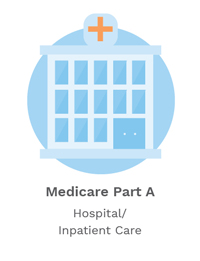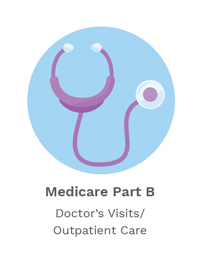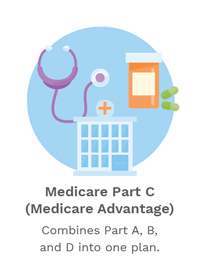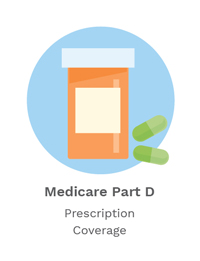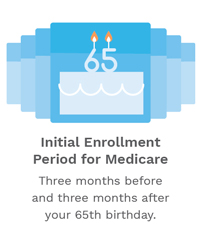Understanding Health Insurance
Inflammatory bowel diseases (IBD) are chronic illnesses that require frequent monitoring, testing, and treatments. Obtaining health insurance to cover healthcare costs can be challenging for those who need it most. There are various public and private health insurance options to help individuals and families obtain affordable healthcare.
Use our IBD Insurance Checklist as a guide to evaluate and compare insurance plans.
View a Facebook Live conversation with Dr. David Rubin, co-director of the Digestive Disease Center at the Univeristy of Chicago Medicine, and Shivani Patel, clinical pharmacy specialist - Gastroenterology at the University of Chicago Medicine, as they discuss picking insurance benefits and appealing coverage decisions.
Read below to learn more about private and public health insurance options.
Jump to:
Private Options | Public Health Insurance
Insurance Information for Older Adults | Insurance Information for Young Adults
Private Options:
Group Insurance
Group insurance is health insurance that you get from an employer, a union, or through a spouse’s employer or union. The employer researches available plans, selects the insurance company, and picks plan options for employees. Coverage is dependent on an individual's (or family member's) employment.
Individual Insurance
These plans are purchased by an individual to cover themselves and/or their family. As an individual, you can select insurance from individual insurance companies or from the Health Insurance Marketplace. Individual insurance plans have a variety of options, but costs and offerings may vary from state to state.
Health Insurance Marketplace
The Health Insurance Marketplace (also known as the Health Insurance Exchange) provides information on health insurance options, compares insurance plans and allows you to apply for coverage. This is helpful if you do not have coverage or would like to explore more cost-effective options. All plans on the Marketplace are considered Qualified Health Plans meaning that they must cover Essential Health Benefits (EHBs), including but not limited to ambulatory patient services; emergency services; hospital coverage; behavioral health; prescription drugs; lab services; and chronic disease management. These plans may be subsidized by the government based on your income. The Marketplace provides affordable options, but can be limited in what they cover. Click here for more information.
Association Health Plans (AHPs)
Association Health Plans (AHPs) are health insurance plans run by small employers that band together as an association. A 2018 regulation by the Trump Administration broadened the scope of small employers and self-employed individuals that are allowed to participate in AHPs. AHPs are not subject to the same regulations and patient protections as plans on the Health Insurance Exchanges. AHPs are required to provide preventive care and allow children under 26 to stay on their parent’s insurance. They are not allowed to charge persons with pre-existing conditions more, but they can base premiums on gender, age, location, and occupation. AHPs are not required to cover Essential Health Benefits such as prescription drugs. Click here for more information.
Short Term Limited Duration Health Plans (STLDHPs)
Short Term Limited Duration Health Plans (STLDHPs) are health insurance plans that are meant to cover a short gap in insurance coverage. STLDHPs are not subject to upholding patient protections like the plans on the Exchanges. STLDPs can deny coverage and charge more based on health status, impose annual and lifetime limits, and choose not to cover the Essential Health Benefits. Earlier this year, the Trump Administration extended STLDHPs from less than three months to 364 days, with the option for consumers to renew plans for up to three years. Click here for more information.
Public Health Insurance:
These health insurance plans are administered by the government. Public health insurance plans include:
Medicaid
Medicaid is a state-administered health insurance program for low-income families and children, pregnant women, the elderly, people with disabilities, and in some states, other adults. The federal government provides a portion of the funding and sets guidelines for Medicaid. States also have choices in how they design their program, so Medicaid programs and eligibility vary from state-to-state, and may have a different name in your state. You qualify for Medicaid based on family size and income and can apply at any time throughout the year. Visit www.medicaid.gov for more information.
Medicare
Medicare is a federal government-administered health insurance program available for people age 65 or older, younger people with disabilities and people with end stage renal disease. Visit www.medicare.gov or call 1-800-MEDICARE (1-800-633-4227) for more information.
Medicare Part A is hospital insurance that helps cover inpatient care in hospitals, skilled nursing facilities, hospice, and home care.
Medicare Part B helps to cover medically necessary services like doctors’ services, outpatient care, home health services and other medical services, as well as some preventive services. Most Medicare beneficiaries are enrolled in Part B automatically. This part of Medicare typically covers infusion biologic costs but frequently has a coinsurance that the patient is responsible for paying.
Medicare Part C, also known as Medicare Advantage Plan (MAP) is a type of health plan offered by a private insurance company and is approved by Medicare to provide you with all your Medicare Part A and Part B benefits. There are many MAP types including Health Maintenance Organizations (HMOs), Preferred Provider Organizations (PPO), Private Fee-for-Service plans, Special Needs plans, and Medicare Medical Savings Account plans. Medicare services are integrated with the health plan so that the health plan benefits are coordinated with Medicare Parts A and B. Most Medicare Advantage Plans offer prescription drug coverage.
Medicare Part D is an optional program that provides prescription drug coverage. There are two ways to get Medicare prescription drug coverage — through a Medicare Prescription Drug Plan (Part D) or a Medicare Advantage Plan that includes drug coverage. These plans are offered by insurance companies and other private companies as approved by Medicare. Part D typically covers injection biologic costs but are subject to the donut hole (below), which may result in high out-of-pocket costs.
Medicare Part D Donut Hole/Coverage Gap is a period of time where there is a coverage gap in your Medicare D plan. Medicare Part D consists of four stages of coverage:
- Deductible: If your plan has a deductible, you usually pay the full cost of your drugs up to the deductible amount.
- Initial Coverage: During this stage, the plan pays its share of the cost and you pay a copayment or coinsurance (your share of the cost) for each prescription you fill until your total drug costs reaches $3,750 (changes year-to-year).
- Coverage Gap/Donut Hole: During this stage, you’ve exceeded the initial coverage limit of your plan so the amount you pay for prescription drugs increases. If you have noticed that you are suddenly paying more for prescription drugs, you may be in the donut hole. This stage continues until your yearly out of pocket drug costs reach $5000 (changes year-to- year).
- Catastrophic Coverage: In this stage, you have left the donut hole and you pay a 5% coinsurance amount for each prescription you fill.
-
Every January 1, your coverage resets back to the Deductible stage (if plan has deductible) or the Initial Coverage stage (if your plan does NOT have a deductible).
Low-Income Subsidy (LIS) or “Medicare Extra Help Program"
The LIS is for Medicare Part D recipients and Medicare/Medicaid dual eligible recipients who have limited income and resources to help pay for prescription drugs. LIS provides financial assistance to patients who may otherwise be unable to afford the costs associated with their Medicare Part D plan. Those who are eligible for LIS may:
- Receive assistance paying their monthly premium
- Have reduced or no deductible
- Have reduced or no prescription coinsurance and copayments
- Have no cap in coverage or donut hole
Click here to learn more and see if you are eligible
For insurance assistance in relation to Medicare, please contact the Medicare Rights Center at 800-333-4114. You could also contact The Center for Medicare Advocacy at 860-456-7790
Most states have counseling programs that can provide free information and assistance on Medicaid/Medicare, commercial insurance, and other health care financing. The Families USA website is a helpful site to look up your state’s health care resources.
For additional assistance on selecting insurance, visit Global Healthy Living’s, “A Patient’s Guide to Insurance Enrollment”
Insurance Information for Older Adults
It’s never too early to start thinking about your Medicare options. If you are nearing retirement or approaching turning 65, it’s important to start thinking about your options for health coverage.
The Initial Enrollment Period (IEP) for Medicare begins three months before your 65th birthday and ends three months after your birthday. The date your Medicare coverage begins is dependent upon the date you sign up.
Coordinated or Supplemental Medicare Insurance
Enrolling in coordinated or supplemental health insurance can help eliminate out-of-pocket costs. There are two options to consider.
Medigap is private insurance that fill in the gaps between your Medicare benefits and what you must pay out-of-pocket. You purchase Medigap plans from private insurance companies to help pay for things that Medicare does not pay for such as copayments, coinsurance, and deductibles.
Medicare Part C, also known as Medicare Advantage Plan (MAP) is a coordinated care plan which means that your Medicare benefits are embedded into the Medicare Advantage plan.
Instead of paying for Parts A, B, and D, a person would enroll in Medicare Advantage through a private insurance company that, in many cases, covers everything provided by Parts A, B, and D and may offer additional services. The beneficiary would pay the Medicare Advantage premium along with the Part B premium in most cases.
It is highly recommended that IBD patients consider applying for supplemental or secondary coverage such as Medicare Part C (Medicare Advantage) or Medigap to help pay for some of the costs not covered by Original Medicare.
| Medicare Part C/Medicare Advantage | Medigap |
|---|---|
| Lower Premiums | Higher premiums |
| Has copays | No copays |
| Caps on out of pocket expenses | Low to no out of pocket expenses |
| Must see providers within the plan | May choose any provider in Medicare |
|
Include Prescription Coverage – Part D |
Must sign up separately for Prescription Coverage – Part D |
| May include extra services (vision, hearing) | Some extra services are not covered |
| No coverage available outside of the US | Coverage outside of US is possible |
Video on Planning for the Cost of IBD Care for Older Adults
Insurance Information for Younger Adults
The Affordable Care Act allows for young adults to remain on their parents’ insurance until the age of 26. Once you turn 26, you must enroll in your own plan. Typically, you will have several options for plans to look at through your employer or your spouse’s employer. If you do not have coverage through an employer, you can purchase a plan through the Health Insurance Marketplace or through a private company.
If you are disabled, you may be eligible to continue coverage under your parent’s plan beyond the age of 26, but this is a very special circumstance.
Picking a plan that meets all of your treatment needs can be confusing, but we’re here to help. Check out our insurance checklist to get a sense of what you want to be looking for in a plan and consult our glossary of healthcare terms if you come across any words you are unfamiliar with.
Below you’ll find additional information on health insurance guidance for young adults, as well as some cost savings options:
Infographic

